Pesticides Market Outlook, 2032
The global pesticides market size was valued at $45.7 billion in 2022, and is projected to reach $92.6 billion by 2032, growing at a CAGR of 7.5% from 2023 to 2032. Pesticides are an essential component of modern agriculture, serving a critical role in protecting crops from the unrelenting attack of pests, diseases, and weeds. These chemicals are intended to regulate and control diverse plant and animal life that process the agricultural output.
Pesticides are a broad group of substances, each designed to solve distinct issues that farmers encounter in their pursuit of sustainable and efficient agricultural development. While pesticides have unquestionably transformed agriculture, guaranteeing abundant harvests and food security, they also raise worries about their environmental effect, potential health dangers, and the development of resistance among target organisms.
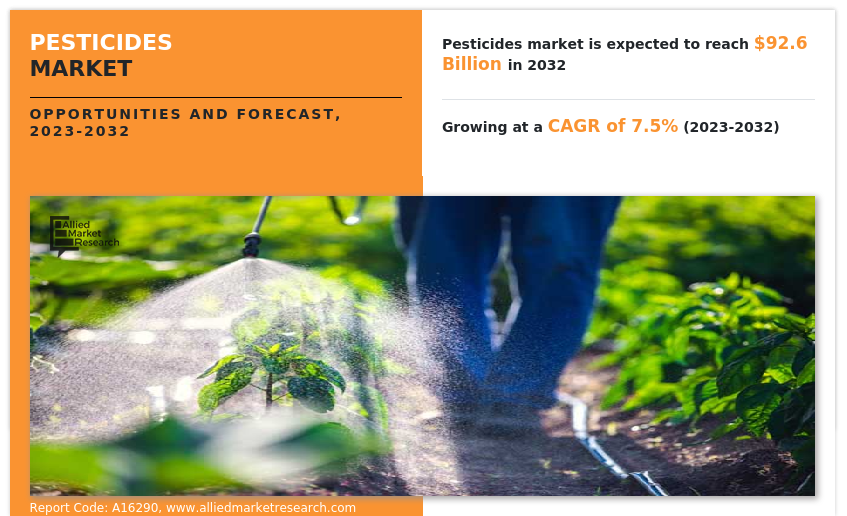
The need to protect crops from numerous pests such as insects, weeds, and diseases is one of the key motives behind the usage of pesticides. Pests have the capacity to destroy whole harvests, resulting in severe economic losses for farmers. Pesticides operate as a barrier, allowing farmers to protect their crops while increasing total production. Without effective pest management, global food supply would be significantly impacted, resulting in food shortages and price increases. Pesticide usage has prompted changes in agricultural techniques, including the introduction of pest-resistant genetically modified (GM) crops.
Biotechnological advancements have enabled the development of pest-resistant crops, lowering the need for external chemical inputs, and supporting sustainable agricultural methods. Pesticides can be administered across wide areas, saving farmers time during important times of crop development. Contrary to popular belief, certain contemporary herbicides are more targeted and ecologically beneficial. Integrated Pest Management (IPM) techniques, which integrate pesticide usage with other sustainable measures, assist to reduce pesticide's environmental effect by lowering overall chemical inputs and improving ecological balance. All these factors projected to drive the pesticides market growth during the forecast period.
Pesticides not only kill pests, but they can also harm beneficial insects and natural predators, which are important in preserving ecological balance. Insecticides, for example, may kill populations of ladybirds, spiders, and predatory beetles, which are natural adversaries of crop-damaging pests. The extinction of these natural predators has the potential to increase pest populations and increase dependency on chemical interventions to manage pest outbreaks. This unanticipated outcome emphasizes the importance of integrated pest control systems that prioritize natural enemy conservation. Effective pesticide control and supervision pose substantial obstacles.
Integrated Pest Management (IPM) is a comprehensive strategy to pest management that incorporates several pest control approaches to obtain long-term and successful outcomes. Farmers may optimize pest management tactics by combining biological control, cultural measures, and the practical use of chemical pesticides. The use of current technology such as sensors, data analytics, and machine learning algorithms improves IPM precision and efficiency. These tools allow for real-time monitoring of environmental conditions and insect populations, allowing farmers to make educated judgements on focused treatments. Drones with high-resolution cameras and sensors take precise photographs of agricultural areas, allowing farmers to monitor crop health and spot insect infestations early on. This early diagnosis allows for tailored actions, reducing the need for extensive pesticide use.
Furthermore, satellite images and data analytics contribute to a more thorough understanding of pest dynamics, allowing for more proactive pest management decision-making. The introduction of digital agricultural platforms has transformed how farmers manage their operations, including pest management. To give complete insights, these systems incorporate data from numerous sources, including weather predictions, soil health evaluations, and insect monitoring. These systems can provide prediction models for insect outbreaks by utilizing artificial intelligence and machine learning algorithms, allowing farmers to take preventative steps. Furthermore, digital agriculture promotes farmer information exchange, encouraging a collaborative atmosphere for better pest management tactics.
The key players profiled in this report include bioworks inc., Bayer Cropscience, Corteva Agriscience, Syngenta AG, BASF SE, Marrone Bio Innovations, Inc., FMC Corporation, Certis USA L.L.C., Adama Agricultural Solutions Ltd., and Dow Inc.. Investment and agreement are common strategies followed by major market players. For instance, in March 2022, FMC India launched a new insecticide Corprima Powered by FMC's world-leading Rynaxypyr insect control technology. Corprima offers crop protection against fruit borers, one of the biggest concerns for Indian farmers.
The pesticides market analysis is segmented on the basis of target, type, crop type, formulation, and region. By target, the market is divided into herbicides, fungicides, and insecticides. By type, the market is classified into bio-pesticides, chemical pesticides, and others. By crop type, the market is divided into vegetables & fruits, oilseeds & pulses, cereals & grains, commercial crops, plantation crops, and others. By formulation, the market is classified into liquid and dry. By region, the market is analyzed across North America, Europe, Asia-Pacific, and LAMEA.
The pesticides market is segmented into Target, Type, Crop Type and Formulation.
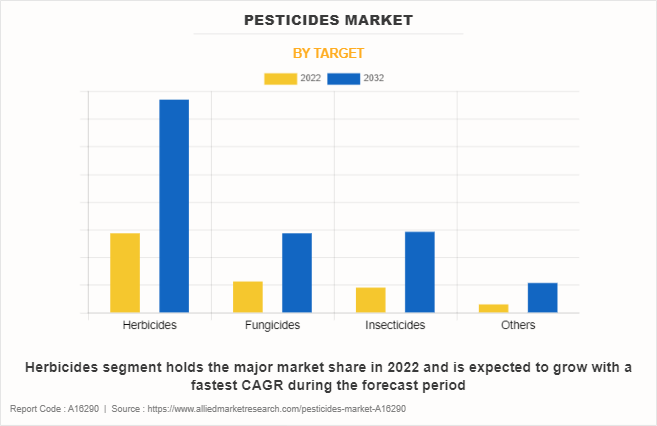
Pesticides Market By Target
By target, the herbicides sub-segment dominated the global pesticides market share in 2022. Herbicides are critical in the control of invasive plant species, which can outcompete and damage native flora. Herbicides are frequently used in initiatives to prevent invasive species and safeguard natural habitats from damage. Herbicides make crop rotation and diversification easier by suppressing weeds that might otherwise hinder the development of different crops in rotation.
Farmers may improve soil health and optimize land usage by using strategic crop rotations, which are made feasible by good weed management. Herbicides come in a variety of formulations, including broad-spectrum and selective formulations. Broad-spectrum herbicides control a wide variety of weed species, whereas selective herbicides target specific weed kinds, allowing for more accurate weed management.
Herbicide application's primary purpose is to eliminate weed competition, resulting in higher crop yields. Higher yields help farmers maintain economic stability while still meeting the expanding global food demand. Herbicides assist to retain soil moisture by minimizing competition for water resources. This is especially significant in water-stressed areas where effective water utilization is critical for sustainable agriculture.
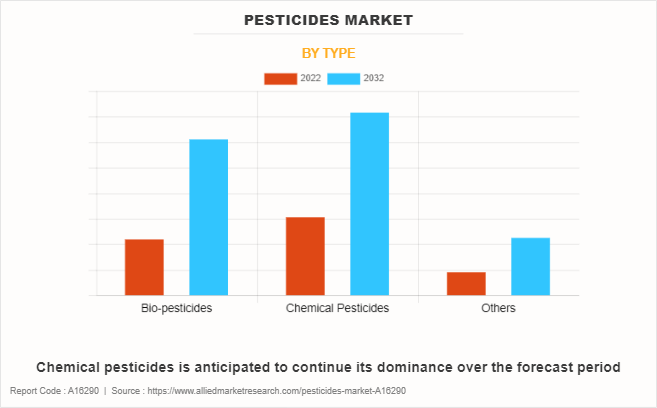
Pesticides Market By Type
By type, the chemical pesticides sub-segment dominated the global pesticides market share in 2022. The major benefit of applying chemical pesticides is an improvement in agricultural production. These insecticides avoid yield losses by successfully managing pests, resulting in a larger output of quality crops. Chemical pesticides help to ensure global food security by protecting crops from pests that would otherwise destroy whole harvests.
This safeguard assures a steady and consistent food supply to fulfil the demands of the world's rising population. Chemical pesticides allow farmers to safeguard their crops more effectively, which results in economic benefits. More yields provide more revenue for farmers, which promotes economic sustainability in agriculturally reliant communities. Contrary to popular opinion, some contemporary chemical insecticides are targeted and ecologically beneficial.
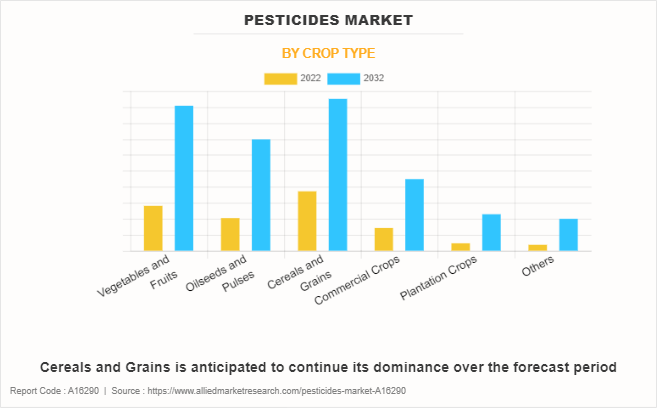
Pesticides Market By Crop Type
By crop type, the cereals & grains sub-segment dominated the global pesticides market share in 2022. Pesticides help to improve crop quality by avoiding insect and disease damage. Higher-quality crops not only fulfil customer tastes, but also supply important nutrients, resulting in a more balanced and healthful diet. Pesticides help farmers' economic well-being by protecting crops and raising yields. Improved farmer livelihoods are critical for rural development, promoting sustainable agricultural methods, and assisting local communities.
Pesticides contribute significantly to global food security by guaranteeing a steady and regular supply of cereals and grains. They contribute to a stable and resilient food production system by mitigating the influence of uncontrollable elements such as weather, pests, and illnesses. Pesticides aid precision agricultural methods by allowing farmers to target specific pest-affected regions or crops. This focused method minimizes total chemical consumption, reducing the environmental impact of agricultural activities. Cereals and grains are important commodities in international trade.
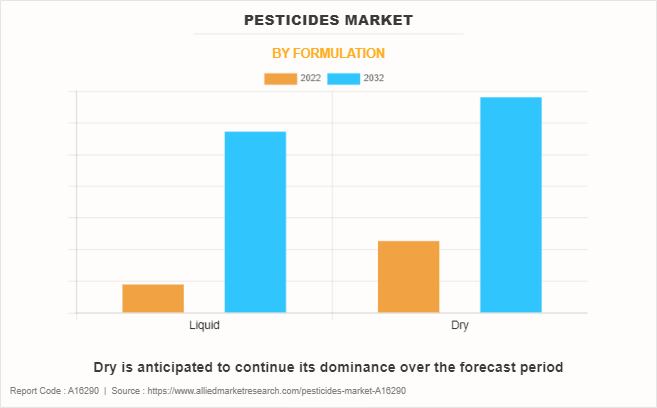
Pesticides Market By Formulation
By formulation, the dry sub-segment dominated the global pesticides market share in 2022. When compared to liquid formulations, dry pesticides frequently contain a higher concentration of active chemicals. This implies that a smaller amount of product can provide the same degree of pest control, lowering the total amount of pesticides used on crops. This concentration also helps to reduce transportation costs and carbon emissions connected with pesticide manufacture and distribution. When applied to crops, dry formulations hold on better to plant surfaces. This enhanced adherence assures better coverage and increases the pesticide's residual action.
Therefore, farmers may need to use pesticides less frequently, lowering both the total environmental effect and operating expenses. Dry insecticides provide for more application flexibility. They can be used as dust, granules, or mixed with other solid carriers. This adaptability enables farmers to select the best application strategy for their unique crops, pests, and field circumstances.
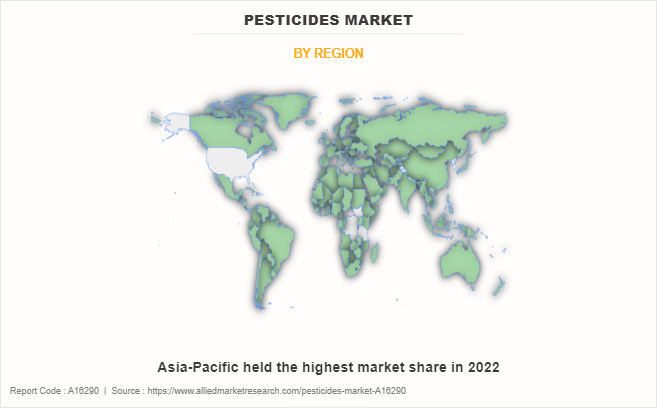
Pesticides Market By Region
By region, Asia-Pacific dominated the global pesticides market share in 2022. The large improvement in agricultural output is one of the key benefits of pesticide use in Asia-Pacific. Farmers can increase yields by safeguarding crops from pests and diseases, further contributing to food security and economic stability. Agriculture technology has also advanced significantly in the region. Precision agricultural techniques, genetically engineered crops, and novel pesticide formulations have boosted pest control efficiency and efficacy.
Farmers are implementing innovative methods to reduce pesticide consumption and environmental effect. Pesticides serve an important role in crop quality preservation by avoiding insect and disease damage. Improved crop quality not only meets consumer preferences, but also increases the market value of agricultural goods, helping farmers and the economy. Farmers may utilize pesticides to reduce losses and provide a more predictable and regular harvest, resulting in enhanced lives and economic well-being for farming communities. Pesticides help to reduce post-harvest losses by avoiding damage throughout the growing and storage stages. This is especially important in Asia-Pacific, where agriculture provides a substantial amount of the population's income.
Key Benefits For Stakeholders
- This report provides a quantitative analysis of the market segments, current trends, estimations, and dynamics of the pesticides market analysis from 2022 to 2032 to identify the prevailing pesticides market opportunities.
- The market research is offered along with information related to key drivers, restraints, and opportunities.
- Porter's five forces analysis highlights the potency of buyers and suppliers to enable stakeholders make profit-oriented business decisions and strengthen their supplier-buyer network.
- In-depth analysis of the pesticides market segmentation assists to determine the prevailing market opportunities.
- Major countries in each region are mapped according to their revenue contribution to the global market.
- Market player positioning facilitates benchmarking and provides a clear understanding of the present position of the market players.
- The report includes the analysis of the regional as well as global pesticides market trends, key players, market segments, application areas, and market growth strategies.
Pesticides Market Report Highlights
| Aspects | Details |
| Market Size By 2032 | USD 92.6 billion |
| Growth Rate | CAGR of 7.5% |
| Forecast period | 2022 - 2032 |
| Report Pages | 290 |
| By Target |
|
| By Type |
|
| By Crop Type |
|
| By Formulation |
|
| By Region |
|
| Key Market Players | bioworks inc., Syngenta AG, BASF SE, Dow Inc., FMC Corporation, Adama Agricultural Solutions Ltd., Marrone Bio Innovations, Inc., Bayer Cropscience, Certis USA L.L.C., Corteva Agriscience |
The pesticides market size is expected to grow due to improved crop quality. In addition, the market growth is driven by technological advancements in the formulation of pesticides.
The major growth strategies adopted by the pesticides market players are investments in R&D and strategic partnerships.
North America will provide more business opportunities for the global pesticides market in the future.
bioworks inc., Bayer Cropscience, Corteva Agriscience, Syngenta AG, and BASF SE, are the major players in the pesticides market.
The herbicides pesticides sub-segment of the target segment acquired the maximum share of the global pesticides market in 2022.
Farmers and agricultural product companies are the major customers in the global pesticides market.
The report provides an extensive qualitative and quantitative analysis of the current trends and future estimations of the global pesticides market from 2022 to 2032 to determine the prevailing opportunities.
Increasing demand for sustainable and bio-based solutions, focus on integrated pest management (IPM), and rise in organic farming practices to drive the global pesticides market expansion.
Loading Table Of Content...
Loading Research Methodology...


